Search Result
Results for "
cytotoxic properties
" in MedChemExpress (MCE) Product Catalog:
2
Isotope-Labeled Compounds
| Cat. No. |
Product Name |
Target |
Research Areas |
Chemical Structure |
-
- HY-148255
-
|
|
Apoptosis
Autophagy
|
Cancer
|
|
QN523 is a novel scaffold with agent-like properties, showing potent in vitro cytotoxicity in a panel of 12 cancer cell lines. QN523 induces apoptosis and autophagy. QN523 can be used in research of cancer .
|
-

-
- HY-14944
-
|
Omacetaxine mepesuccinate; HHT
|
STAT
|
Cancer
|
|
Homoharringtonine (Omacetaxine mepesuccinate;HHT) is a cytotoxic alkaloid with antitumor properties which acts by inhibiting translation elongation.
|
-
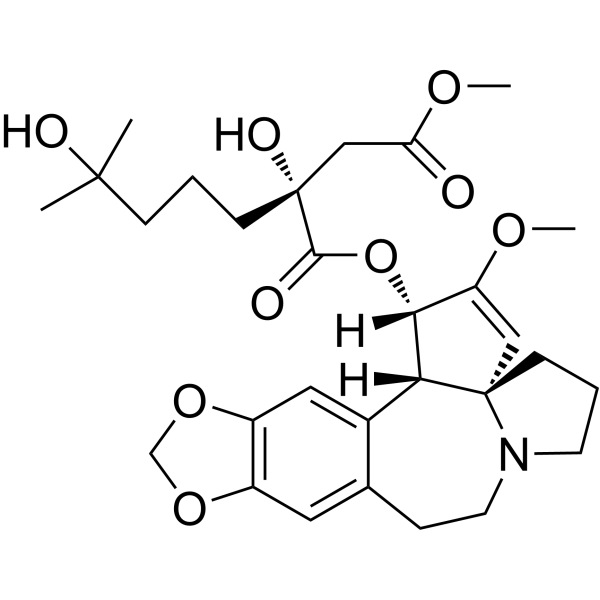
-
- HY-N1621
-
|
|
Fungal
Parasite
|
Infection
|
|
1-Deacetylnimbolinin B is a nimbolinin-type limonoid isolated from the fruits of Melia toosendan. Limonoids are a class of highly oxygenated nortriterpenoids that exhibit insecticidal, antifungal, nematicidal and cytotoxic properties .
|
-
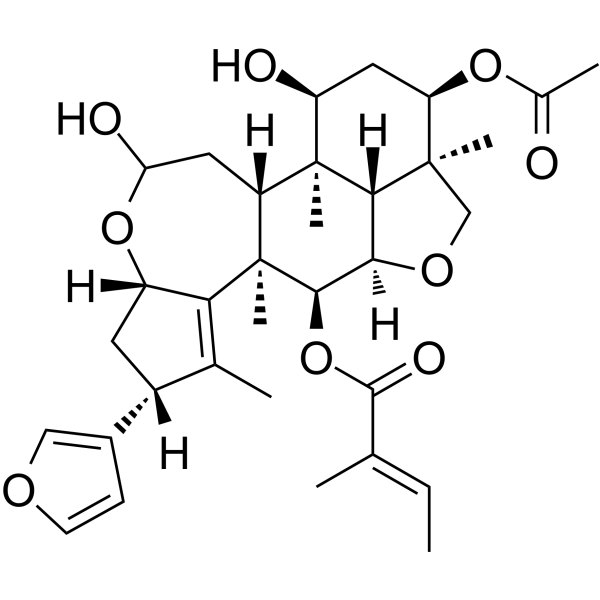
-
- HY-N1318S
-
-
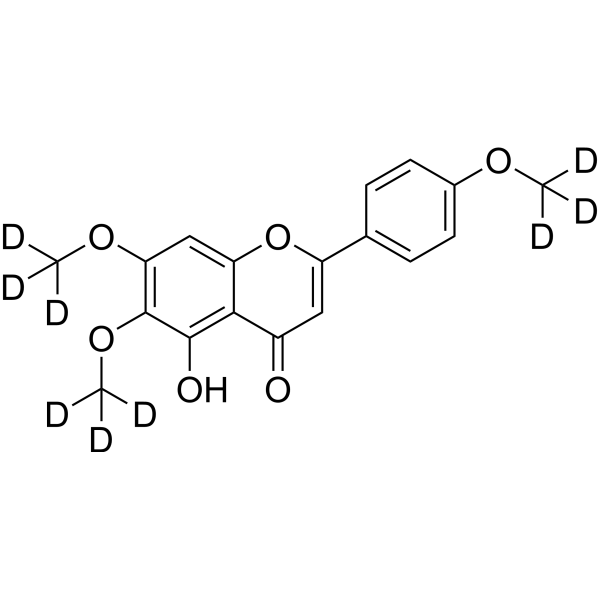
-
- HY-N9737
-
|
|
Others
|
Neurological Disease
|
|
(−)-Acutumine is a tetracyclic chloroalkaloid that exhibits selective cytotoxicity to cultured human T cells and memory-enhancing properties in the Wistar rat model .
|
-
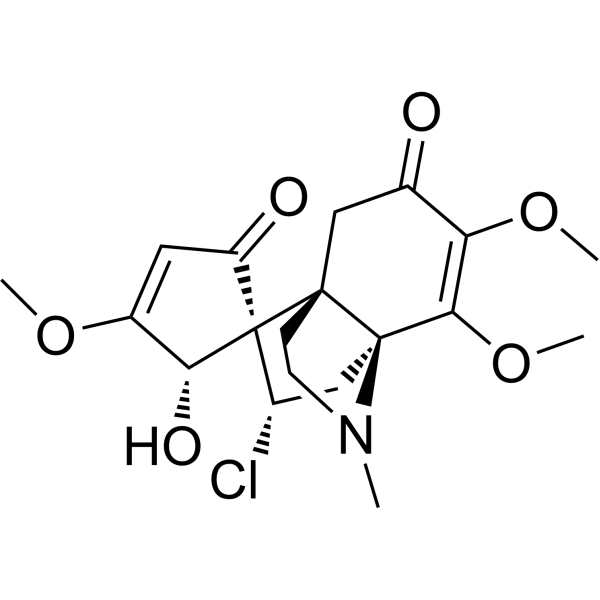
-
- HY-N12524
-
|
|
Bacterial
|
Infection
Cancer
|
|
Cyclo(prolyltyrosyl) is a natural compound that can be found in various microorganisms and marine sponges. Cyclo(prolyltyrosyl) has antibacterial, phytotoxic and cytotoxic properties .
|
-
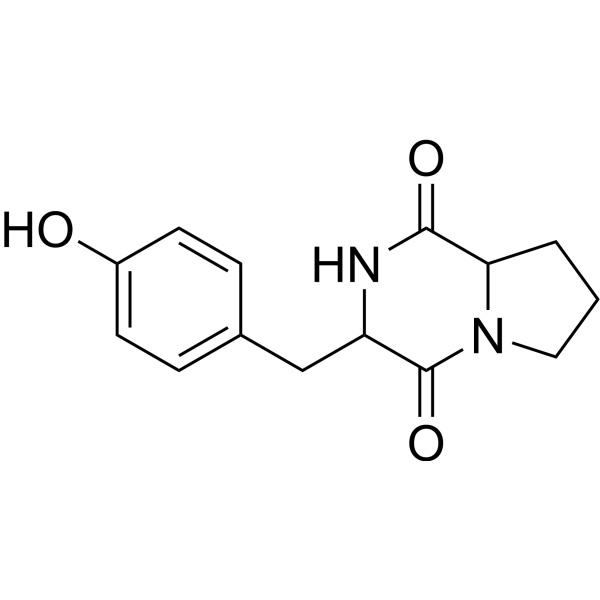
-
- HY-N6714
-
|
|
Topoisomerase
|
Infection
Cancer
|
|
Alternariol is a mycotoxin produced by Alternaria species. AOH inhibits the catalytic activity of topoisomerase I and topoisomerase II enzymes . Alternariol exhibits a variety of therapeutic and biological properties such as phytotoxicity, cytotoxicity, anti-HIV, anti-cancer, and anti-microbial properties .
|
-
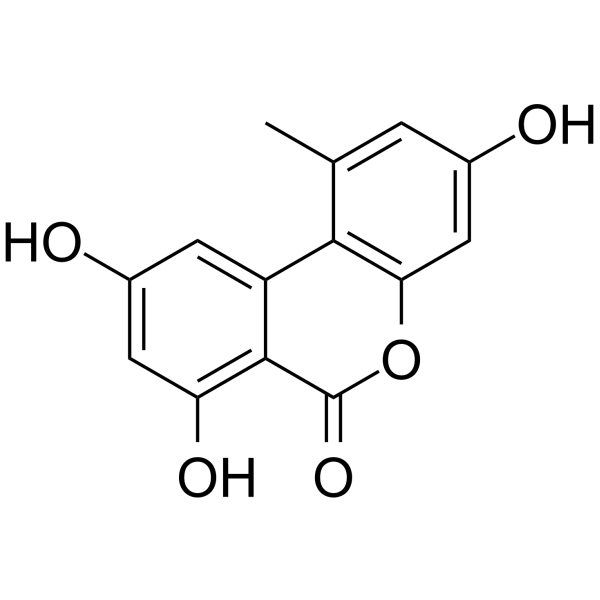
-
- HY-N3968
-
|
GTN; (R)-(+)-Goniothalamin
|
Apoptosis
|
Inflammation/Immunology
Cancer
|
|
Goniothalamin (GTN) is styryllactone with anticancer, anti-inflammatory, immunosuppressive properties. Goniothalamin induces cytotoxicity, DNA damage and apoptosis of a variety of cancer cell lines .
|
-

-
- HY-N2732
-
|
6-Prenyl-4',5,7-trihydroxyflavone; 6-C-Prenylapigenin
|
Others
|
Cancer
|
|
6-Prenylapigenin is a biologically active flavonoid with anti-tumor activity and antiangiogenic properties. 6-Prenylapigenin exerts cytotoxicity against cancer cells, such as leukemia and solid cancer cells .
|
-
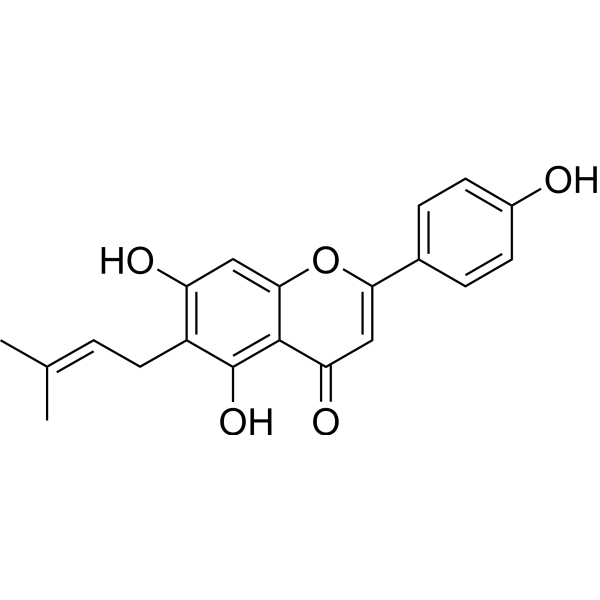
-
- HY-143747
-
|
|
Influenza Virus
|
Infection
|
|
Cap-dependent endonuclease-IN-5 is a potent inhibitor of cap-dependent endonuclease (CEN). Cap-dependent endonuclease-IN-5 inhibits influenza virus well, and/or has lower cytotoxicity, better in vivo pharmacokinetic properties and in vivo pharmacodynamic properties (extracted from patent WO2020078401A1, compound 13-1) .
|
-
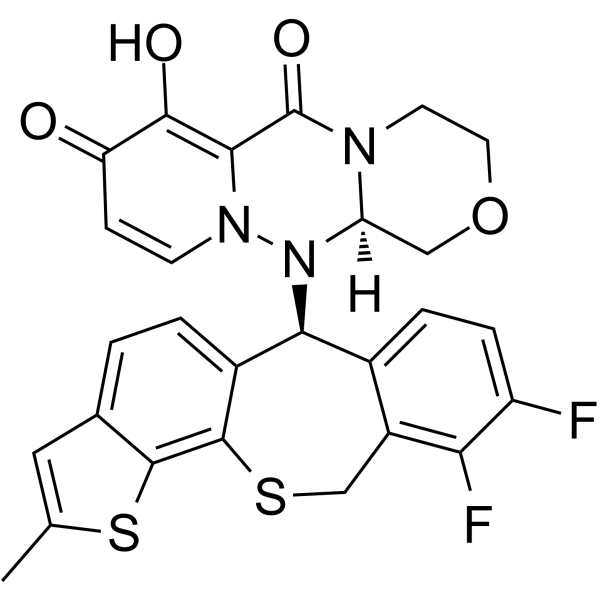
-
- HY-N4020
-
|
|
Others
|
Others
|
|
Icariside E5 is a lignan glycoside isolated from the Capsicum annuum. Icariside E5 promotes the proliferation of HUVECs without cytotoxicity. Icariside E5 has antioxidant properties .
|
-

-
- HY-N1318
-
-
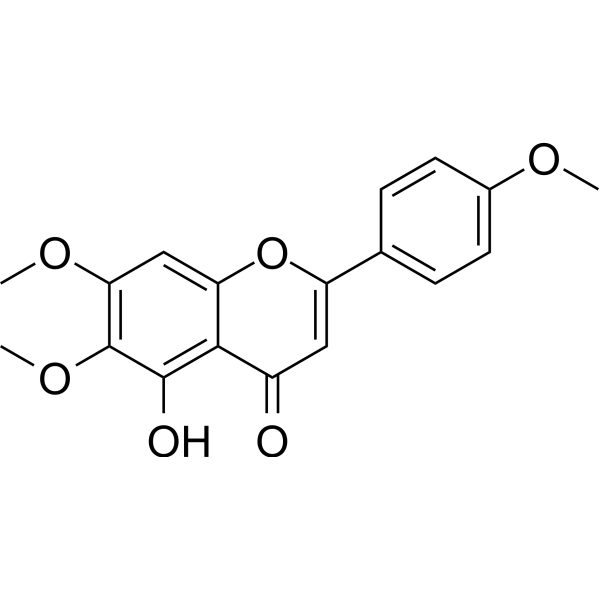
-
- HY-N0006S
-
-

-
- HY-150754
-
|
|
Bacterial
|
Infection
|
|
FtsZ-IN-4 is an orally active FtsZ (filamenting temperature-sensitive mutant Z) inhibitor, exhibits excellent antibacterial activity. FtsZ-IN-4 shows good pharmaceutical properties with low cytotoxicity (CC50 >20 μg/mL) .
|
-

-
- HY-155546
-
|
|
Bacterial
|
Infection
|
|
Antimicrobial agent-22 (THI 6c) is a multi-target broad-spectrum antibacterial agent. Antimicrobial agent-22 has low cytotoxicity, hemolytic property, rapid bactericidal ability and good anti-biofilm activity .
|
-
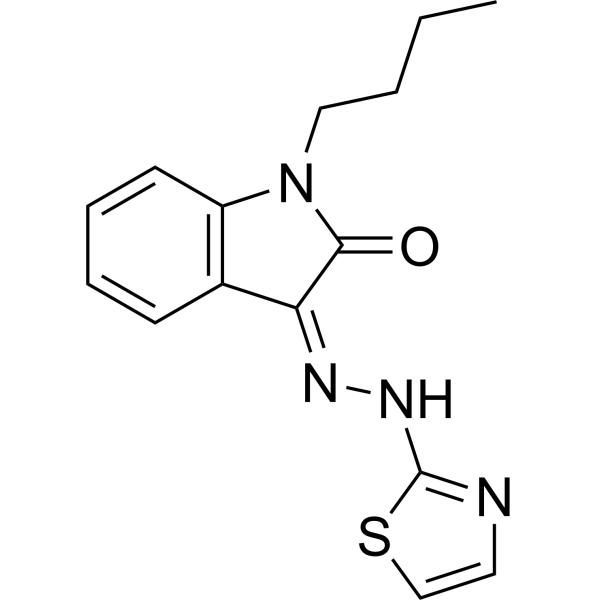
-
- HY-P1632
-
|
|
Bacterial
|
Infection
Cancer
|
|
Tachyplesin I is a β-hairpin antimicrobial peptide that contains 17 amino acid residues. Tachyplesin I exhibits cytotoxic properties against various human tumor cell lines acting primarily by impairing the integrity of the outer cell membrane .
|
-

-
- HY-N0206
-
|
Deglucocyclamin; LTS-4; Saxifragifolin B
|
Antibiotic
|
Cancer
|
|
Ardisiacrispin A (Deglucocyclamin) is a common triterpenoid saponin from Ardisia species. Ardisiacrispin A has similar biological properties with some triterpenoid saponins in A. crenata which is one of the species of genus Ardisia and exhibits cytotoxic effect on tumor cells, immunomodulatory and antiviral activities .
|
-

-
- HY-N1243
-
|
|
Microtubule/Tubulin
Apoptosis
|
Cancer
|
|
Tubulysin B is a highly cytotoxic peptide and potent microtubule destabilizing agents isolated from the myxobacteria Archangium geophyra and Angiococcus disciformis. Tubulysin B has IC50 values in the picomolar range against many cancer cell lines, including those with multidrug resistant properties .Tubulysin B is a cytotoxic activity tubulysin which inhibits tubulin polymerization and leads to cell cycle arrest and apoptosis .
|
-

-
- HY-D1504
-
|
|
Fluorescent Dye
|
Others
|
|
IR-797 chloride is a near-infrared (NIR) dye. IR 797 has absorption maxima near 700 nm. IR-797 shows some aggregation-induced-emission (AIE) properties. IR-797 shows shows cytotoxic .
|
-
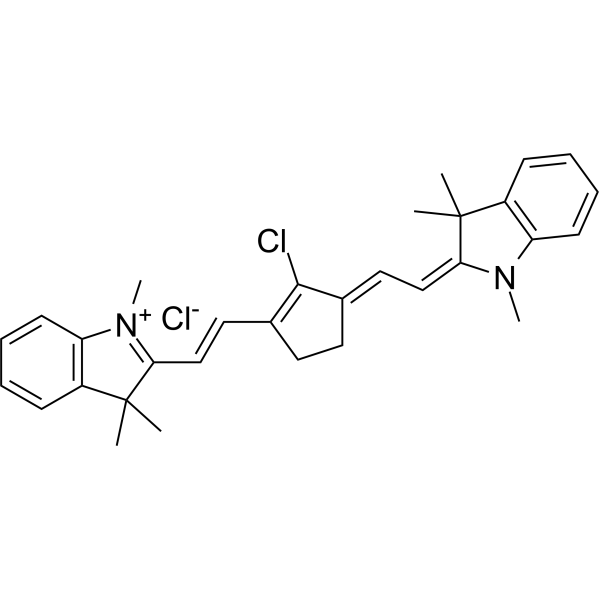
-
- HY-146096
-
|
|
P-glycoprotein
Apoptosis
|
Cancer
|
|
RMS3, a tetrandrine analogue, is a potent P-glycoprotein (P-gp) inhibitor. RMS3 has markedly antiproliferative and cytotoxic effects on cancer cells. RMS3 causes PARP cleavage, a marker for cells undergoing apoptosis. RMS3 has strong anticancer property .
|
-
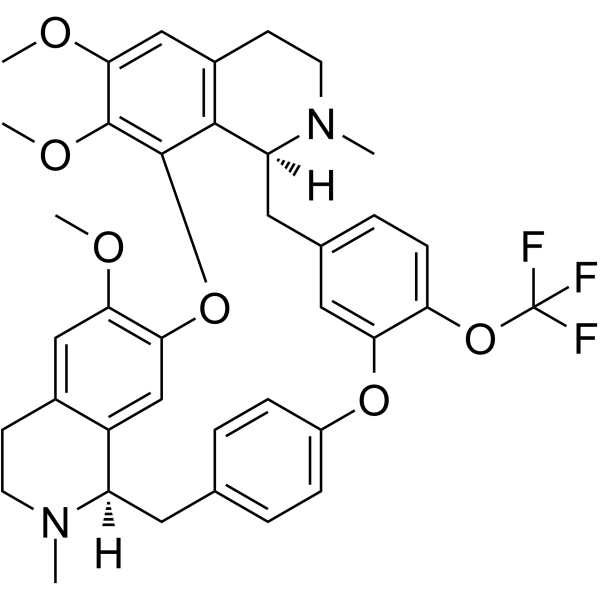
-
- HY-15142A
-
|
Hydroxydaunorubicin
|
ADC Cytotoxin
Antibiotic
Bacterial
Topoisomerase
AMPK
HIV
Autophagy
Mitophagy
Apoptosis
HBV
|
Infection
Cancer
|
|
Doxorubicin (Hydroxydaunorubicin), a broad-spectrum anthracycline antibiotic with cytotoxic properties, is an anti-cancer chemotherapy agent. Doxorubicin has fluorescence properties. Doxorubicin inhibits topoisomerase II with an IC50 of 2.67 μM, thus stopping DNA replication. Doxorubicin reduces basal phosphorylation of AMPK and its downstream target acetyl-CoA carboxylase. Doxorubicin induces apoptosis and autophagy . Doxorubicin inhibits human DNA topoisomerase I with an IC50 of 0.8 μM .
|
-
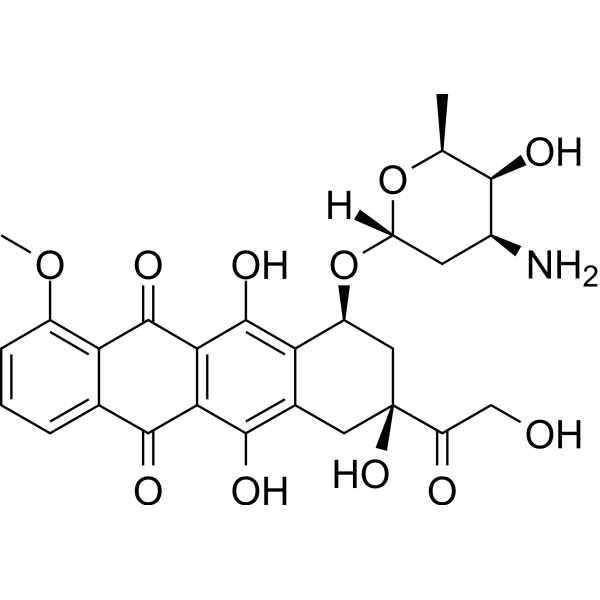
-
- HY-143744
-
|
|
Influenza Virus
|
Infection
|
|
Cap-dependent endonuclease-IN-3 is a potent inhibitor of cap-dependent endonuclease (CEN). Not only can Cap-dependent endonuclease-IN-3 inhibit influenza virus well, but also has lower cytotoxicity, better in vivo agent kinetic properties and in vivo pharmacodynamic properties. Cap-dependent endonuclease-IN-3 has the potential for the research of influenza A and influenza B infection (extracted from patent WO2019141179A1, compound VI-1) .
|
-
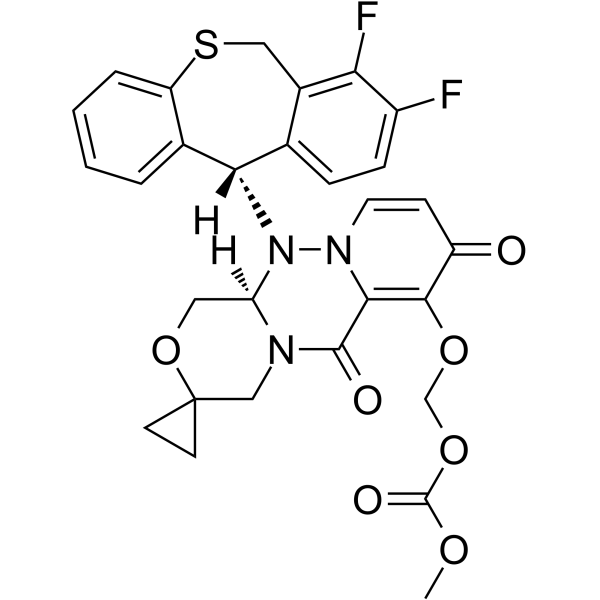
-
- HY-143743
-
|
|
Influenza Virus
|
Infection
|
|
Cap-dependent endonuclease-IN-2 is a potent inhibitor of cap-dependent endonuclease (CEN). Not only can Cap-dependent endonuclease-IN-2 inhibit influenza virus well, but also has lower cytotoxicity, better in vivo agent kinetic properties and in vivo pharmacodynamic properties. Cap-dependent endonuclease-IN-2 has strong inhibitory effect on RNA polymerase activity of A virus (extracted from patent WO2019052565A1, compound 28) .
|
-
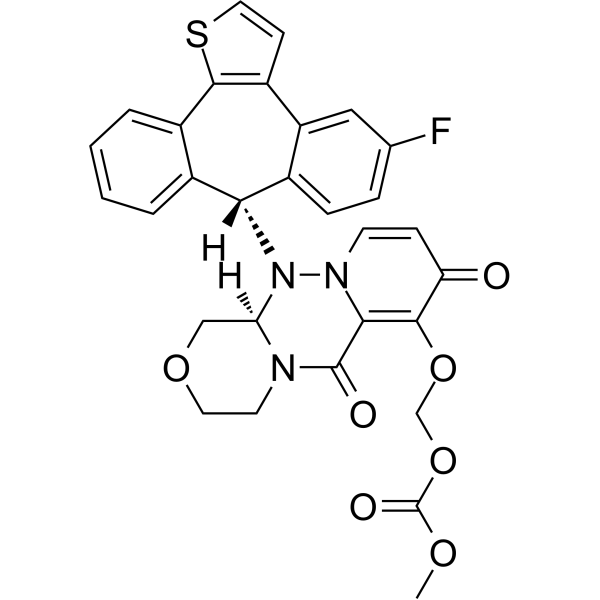
-
- HY-143755
-
|
|
Influenza Virus
|
Infection
|
|
Cap-dependent endonuclease-IN-9 is a potent inhibitor of cap-dependent endonuclease (CEN). Not only can Cap-dependent endonuclease-IN-9 inhibit influenza virus well, but also has lower cytotoxicity, better in vivo agent kinetic properties and in vivo pharmacodynamic properties. Cap-dependent endonuclease-IN-9 has strong inhibitory effect on RNA polymerase activity of A virus (extracted from patent CN112521386A, compound VI-1) .
|
-
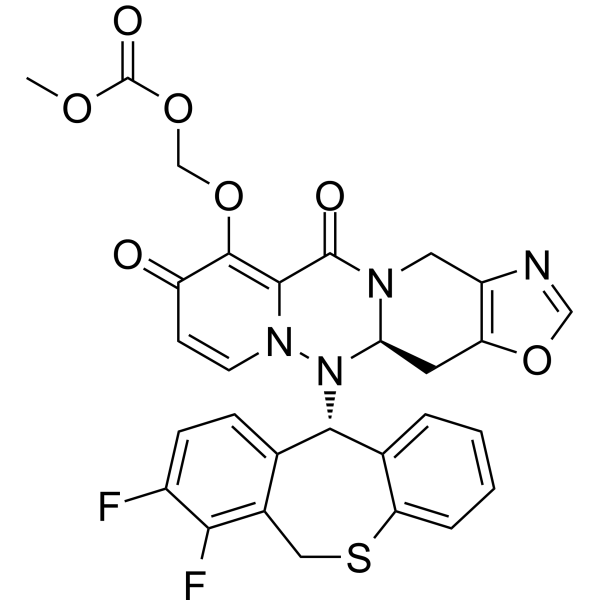
-
- HY-12522
-
|
Aur0101; Auristatin-0101
|
Microtubule/Tubulin
ADC Cytotoxin
|
Cancer
|
|
PF-06380101 (Aur0101), an auristatin microtubule inhibitor, is a cytotoxic Dolastatin 10 analogue. PF-06380101 (Aur0101) shows excellent potencies in tumor cell proliferation assays and differential ADME properties when compared to other synthetic auristatin analogues that are used in the preparation of ADCs.
|
-
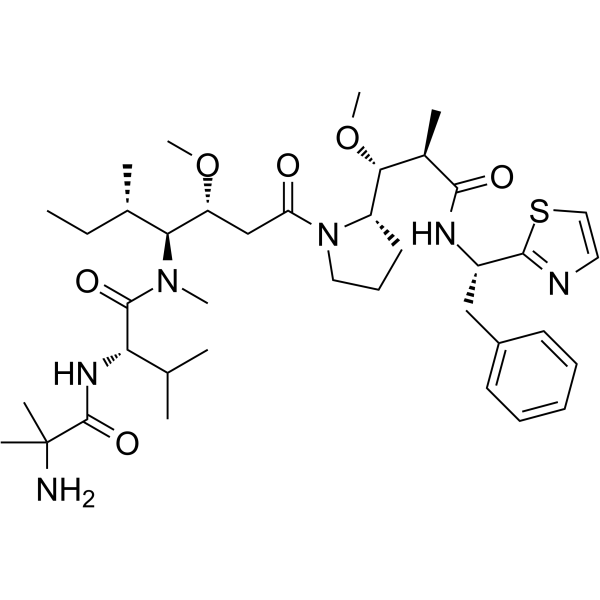
-
- HY-P9921
-
|
Ado-Trastuzumab emtansine; PRO132365; T-DM 1
|
Antibody-Drug Conjugates (ADCs)
EGFR
|
Cancer
|
|
Trastuzumab emtansine (Ado-Trastuzumab emtansine) is an antibody-drug conjugate (ADC) that incorporates the HER2-targeted antitumor properties of trastuzumab with the cytotoxic activity of the microtubule-inhibitory agent DM1 (derivative of maytansine). Trastuzumab emtansine can be used for the research of advanced breast cancer .
|
-

-
- HY-156593
-
|
|
ROCK
|
Cancer
|
|
ROCK-IN-9 (Compound T345) is a ROCK inhibitor. ROCK-IN-9 shows cytotoxicity in HepG2 cell, with an IC50 of 40.8 μM. ROCK-IN-9 has good pharmacokinetic properties in mice, and shows high in vivo exposure and oral bioavailability at lower doses .
|
-

-
- HY-P9921A
-
|
Ado-Trastuzumab emtansine (solution) ; PRO132365 (solution) ; T-DM 1 (solution)
|
Antibody-Drug Conjugates (ADCs)
EGFR
|
Cancer
|
|
Trastuzumab emtansine (Ado-Trastuzumab emtansine) is an antibody-drug conjugate (ADC) that incorporates the HER2-targeted antitumor properties of trastuzumab with the cytotoxic activity of the microtubule-inhibitory agent DM1 (derivative of maytansine). Trastuzumab emtansine can be used for the research of advanced breast cancer .
|
-

-
- HY-N0446
-
|
|
ADC Cytotoxin
|
Cancer
|
|
10-Methoxycamptothecin is a natural bioactive derivative of camptothecin (CPT) isolated from Camptotheca acuminata, and has been confirmed to possess high anti-cancer properties. 10-Methoxycamptothecin has higher cytotoxicity than 10-hydroxycamptothecin by testing antitumor activity against 2774 cell lines .
|
-

-
- HY-P2569
-
|
|
Apoptosis
|
Cancer
|
|
Malformin A1, a cyclic pentapeptide isolated from Aspergillus niger, possess a range of bioactive properties including antibacterial activity. Malformin A1 shows potent cytotoxic activities on human colorectal cancer cells. Malformin A1 induces apoptosis by activating PARP, caspase 3, -7, and -9 .
|
-
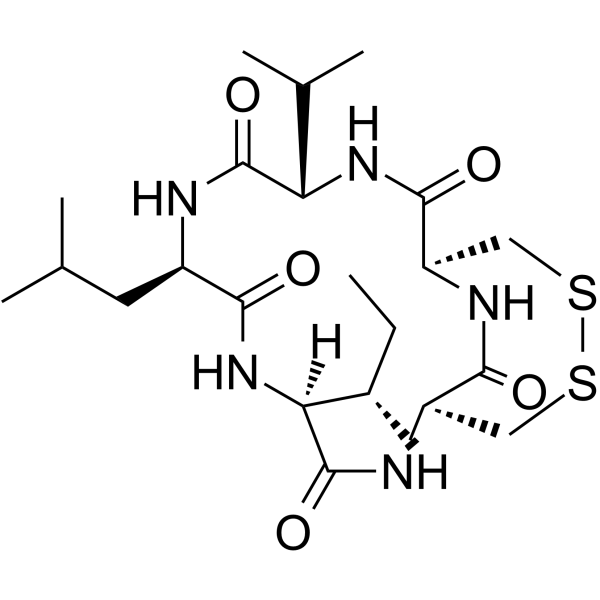
-
- HY-W001187
-
Tempo
2 Publications Verification
|
Mitochondrial Metabolism
DNA/RNA Synthesis
Reactive Oxygen Species
|
Cancer
|
|
Tempo is a nitric oxide radical and a selective scavenger of ROS in mitochondria. Tempo is also an organocatalyst that disproportionates superoxide and oxidizes primary alcohols to aldehydes in a catalytic cycle. Tempo has mutagenic and antioxidant effects and can induceDNA strand breaks. Tempo also exerts cytotoxic and mutagenic properties in mouse lymphoma cells .
|
-
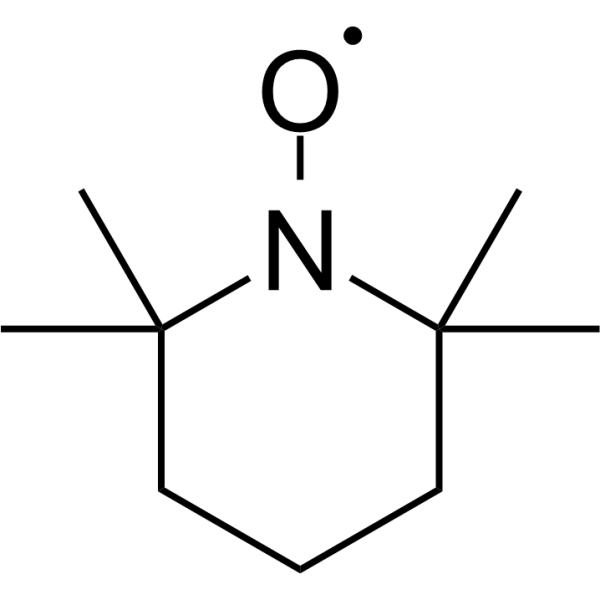
-
- HY-120574
-
|
|
ADC Cytotoxin
Topoisomerase
|
Cancer
|
|
TH1338 (compound 3b), an orally active camptothecin derivative and a potent chemotherapeutic agent for cancer, demonstrates excellent cytotoxic potency against human tumor cell lines in vitro. TH1338 (compound 3b) possesses significant brain penetration, favorable efflux pump properties, and hematological toxicity profile .
|
-
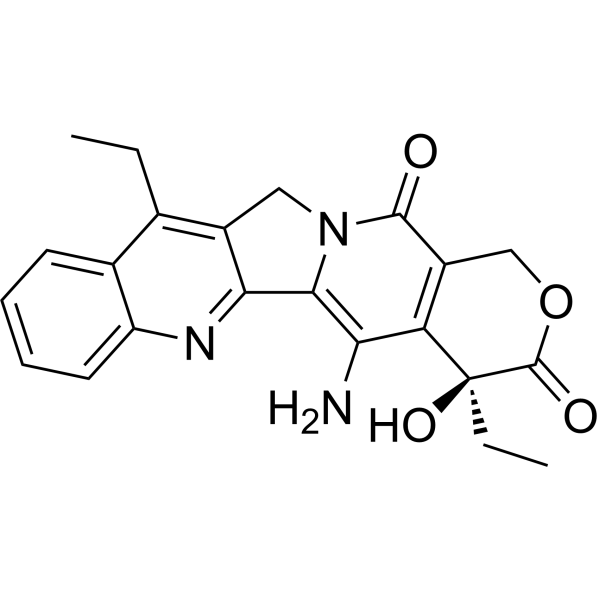
-
- HY-145857
-
|
|
HSP
Apoptosis
|
Cancer
|
|
GRP78-IN-1 exhibits several interactions with GRP78 residues with binding energy of -8.07 kcal/mol. GRP78-IN-1 shows the potent cytotoxic, anti-proliferative in cancer cells. GRP78-IN-1 exhibits promising apoptosis in breast cancer cells and wound healing properties .
|
-
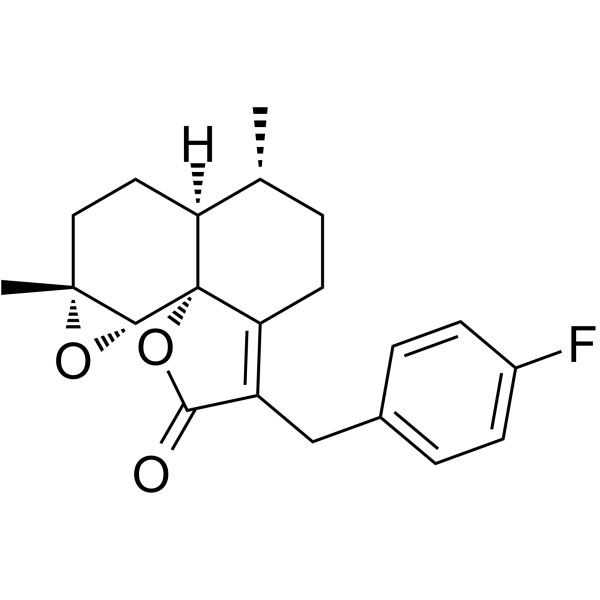
-
- HY-149223
-
|
|
Bacterial
|
Infection
|
|
FtsZ-IN-5 is a potent FtsZ inhibitor, to promote FtsZ polymerization and inhibit GTPase activity of FtsZ. Thus, FtsZ-IN-5 inhibits bacterial division to lead to death of bacterial cells. FtsZ-IN-5 shows bactericidal activity with no significant tendency to trigger bacterial resistance as well as rapid bactericidal properties. And FtsZ-IN-5 shows low hemolytic activity and cytotoxicity to mammalian cells .
|
-
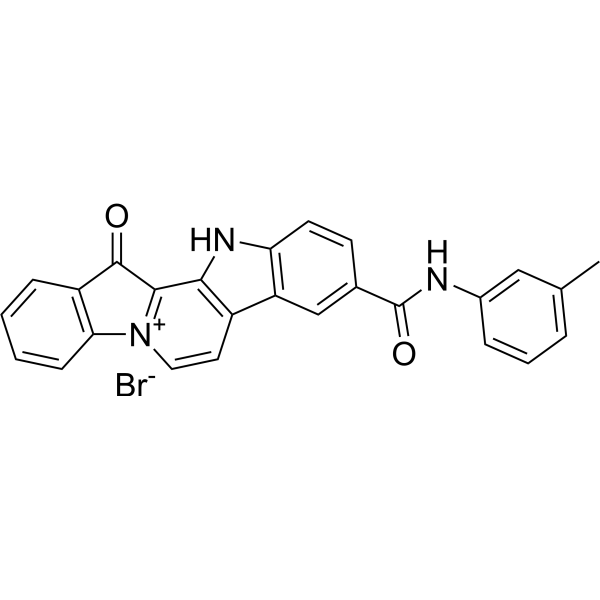
-
- HY-149224
-
|
|
Bacterial
|
Infection
|
|
FtsZ-IN-6 is a potent FtsZ inhibitor, to promote FtsZ polymerization and inhibit GTPase activity of FtsZ. Thus, FtsZ-IN-6 inhibits bacterial division to lead to death of bacterial cells. FtsZ-IN-6 shows bactericidal activity with no significant tendency to trigger bacterial resistance as well as rapid bactericidal properties. And FtsZ-IN-6 shows low hemolytic activity and cytotoxicity to mammalian cells .
|
-
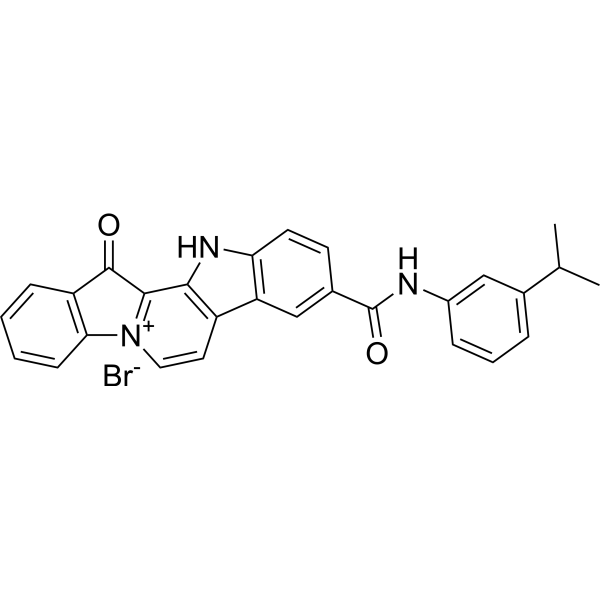
-
- HY-149225
-
|
|
Bacterial
|
Infection
|
|
FtsZ-IN-7 is a potent FtsZ inhibitor, to promote FtsZ polymerization and inhibit GTPase activity of FtsZ. Thus, FtsZ-IN-7 inhibits bacterial division to lead to death of bacterial cells. FtsZ-IN-7 shows bactericidal activity with no significant tendency to trigger bacterial resistance as well as rapid bactericidal properties. And FtsZ-IN-7 shows low hemolytic activity and cytotoxicity to mammalian cells .
|
-
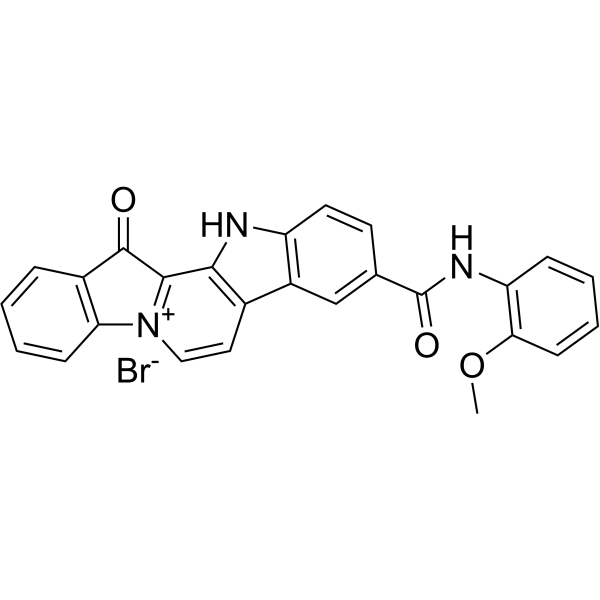
-
- HY-149226
-
|
|
Bacterial
|
Infection
|
|
FtsZ-IN-8 is a potent FtsZ inhibitor, to promote FtsZ polymerization and inhibit GTPase activity of FtsZ. Thus, FtsZ-IN-8 inhibits bacterial division to lead to death of bacterial cells. FtsZ-IN-8 shows bactericidal activity with no significant tendency to trigger bacterial resistance as well as rapid bactericidal properties. And FtsZ-IN-8 shows low hemolytic activity and cytotoxicity to mammalian cells .
|
-
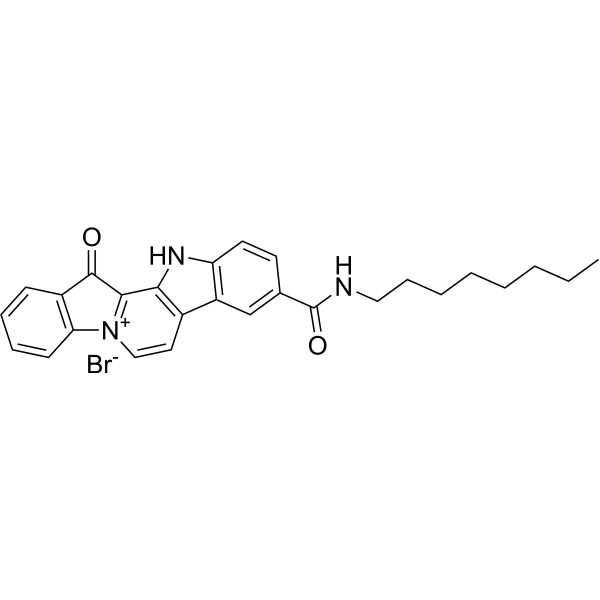
-
- HY-146097
-
|
|
P-glycoprotein
Apoptosis
|
Cancer
|
|
RMS5, a tetrandrine analogue, is a potent P-glycoprotein (P-gp) inhibitor. RMS5 has markedly antiproliferative and cytotoxic effects on cancer cells. RMS5 slightly diminishes the expression of the anti-apoptotic Bcl-2 family proteins Bcl-XL and Mcl-1. RMS3 causes PARP cleavage, a marker for cells undergoing apoptosis. RMS5 has strong anticancer property .
|
-
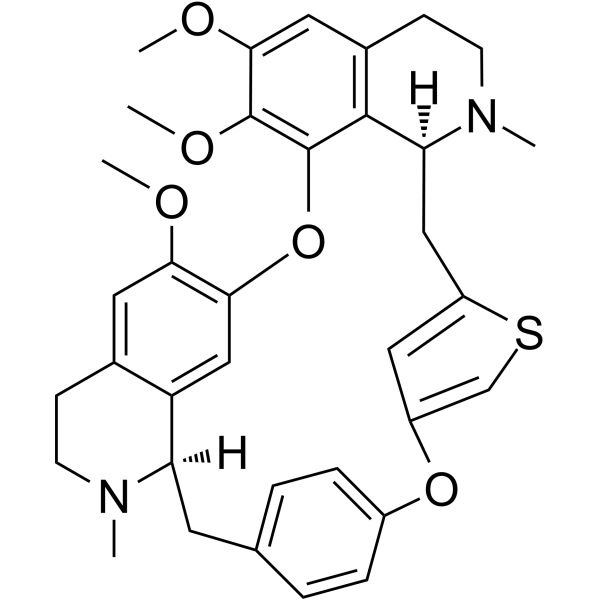
-
- HY-N0057
-
|
3,4-Di-O-caffeoylquinic acid; Isochlorogenic acid B
|
Glucosidase
Influenza Virus
Apoptosis
Endogenous Metabolite
|
Infection
Cancer
|
|
3,4-Dicaffeoylquinic acid (3,4-Di-O-caffeoylquinic acid), naturally isolated from Laggera alata, has antioxidative, DNA protective, neuroprotective and hepatoprotective properties. 3,4-Dicaffeoylquinic acid exerts apoptosis-mediated cytotoxicity and α-glucosidase inhibitory effects. 3,4-Dicaffeoylquinic acid possesses a unique mechanism of anti-influenza viral activity, that is, enhancing viral clearance by increasing TRAIL .
|
-
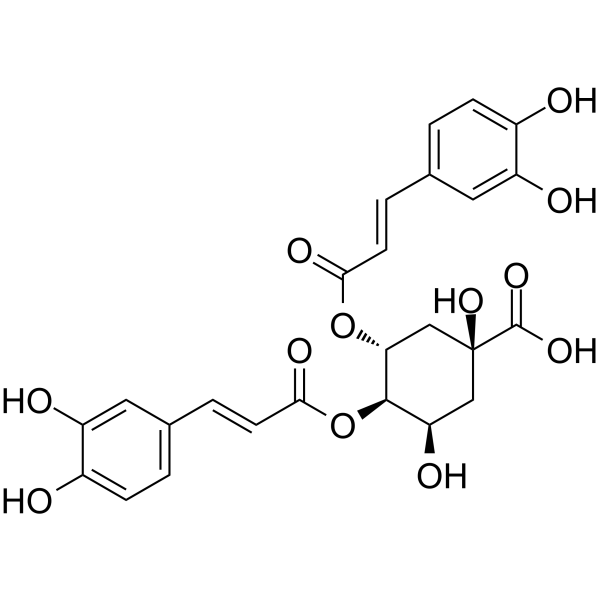
-
- HY-B1064
-
|
Clindamycin 2-phosphate; U-28508
|
Bacterial
Antibiotic
Parasite
|
Infection
|
|
Clindamycin phosphate (Clindamycin 2-phosphate) is a broad-spectrum bacteriostatic lincosamide antibiotic. Clindamycin phosphate is the proagent of Clindamycin (HY-B1455) with no antimicrobial activity in vitro but can be rapidly converted in vivo to the active parent agent, Clindamycin, by phosphatase ester hydrolysis. Clindamycin phosphate can be used for researching acne and bacterial vaginosis .Clindamycin phosphate has no cytotoxicity。 Combined with platelet rich fibrin (PRF), PRF-Clindamycin phosphate enhances antimicrobial properties .
|
-

-
- HY-128952
-
|
SG3249
|
Drug-Linker Conjugates for ADC
DNA Alkylator/Crosslinker
|
Cancer
|
|
Tesirine (SG3249) is an antibody-drug conjugate (ADC) pyrrolobenzodiazepine (PBD) dimer payload. Tesirine combines potent antitumor activity with desirable physicochemical properties such as favorable hydrophobicity and improved conjugation characteristics. SG3199 (HY-101161) is the released warhead component of the ADC payload Tesirine. SG3199 retains picomolar activity in a panel of cancer cell lines. PBD dimers are highly efficient DNA minor groove cross-linking agents with potent cytotoxicity .
|
-
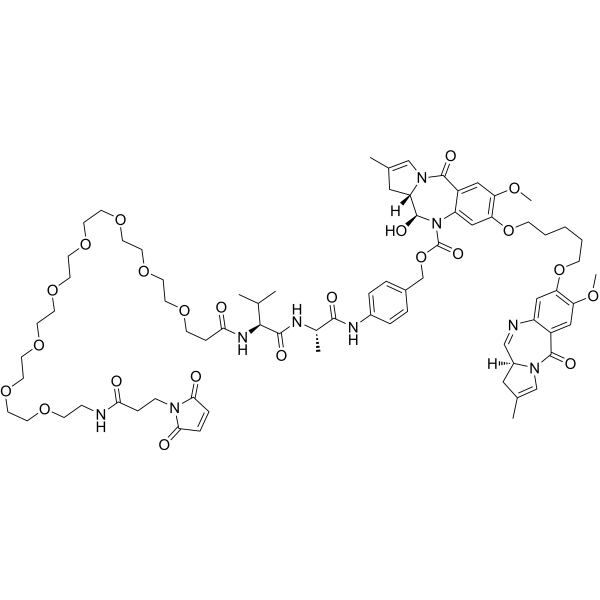
-
- HY-114778
-
|
SHR3162; Fuzuloparib
|
PARP
|
Cancer
|
|
Fluzoparib (SHR3162) is a potent and orally active PARP1 inhibitor (IC50=1.46±0.72 nM, a cell‐free enzymatic assay) with superior antitumor activity. Fluzoparib selectively inhibits the proliferation of homologous recombination repair (HR)‐deficient cells, and sensitizes both HR‐deficient and HR‐proficient cells to cytotoxic agents. Fluzoparib exhibits good pharmacokinetic properties in vivo and can be used for BRCA1/2-mutant relapsed ovarian cancer research .
|
-
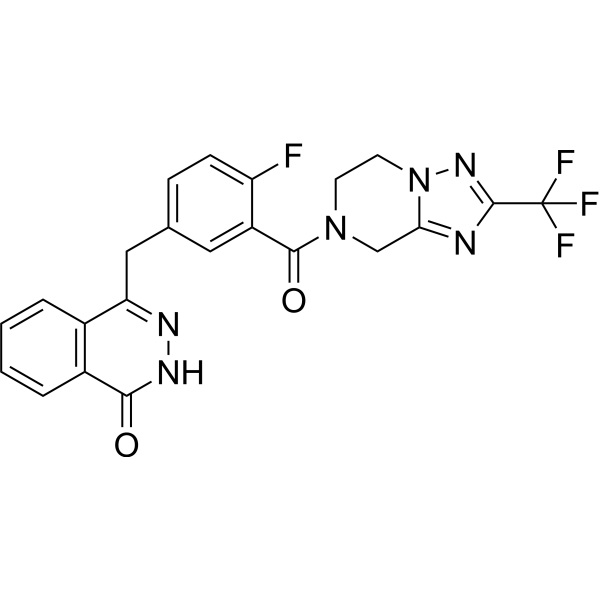
-
- HY-143757
-
|
|
Influenza Virus
|
Infection
|
|
Cap-dependent endonuclease-IN-10 is a potent inhibitor of cap-dependent endonuclease (CEN). Not only can Cap-dependent endonuclease-IN-10 inhibit influenza virus well, but also has lower cytotoxicity, better in vivo pharmacokinetic and in vivo pharmacodynamic properties, and better hepatic microsomal stability. Cap-dependent endonuclease-IN-10 has the potential for the research of viral infections (including influenza A, influenza B and influenza C) (extracted from patent WO2021129799A1, compound 1-1) .
|
-

-
- HY-N7432
-
|
|
Antibiotic
Bacterial
Fungal
|
Infection
|
|
DIMBOA, an antibiotic, has antibacterial properties and inhibits bacteria such as Staphylococcus aureus and the mycotoxin-producing fungus Fusarium graminearum (which causes scab). DIMBOA exhibits strong free radical scavenging activity and weak iron(III) ion reducing activity, and has antioxidant activity. DIMBOA inhibits the biosynthesis and accumulation of toxic trichothecenes by affecting the expression of Tri6 and Tri5. DIMBOA reduces plant susceptibility to scab. DIMBOA also exhibits cytotoxicity to plant cells, causing plasmolysis, cell collapse, and cell rupture .
|
-
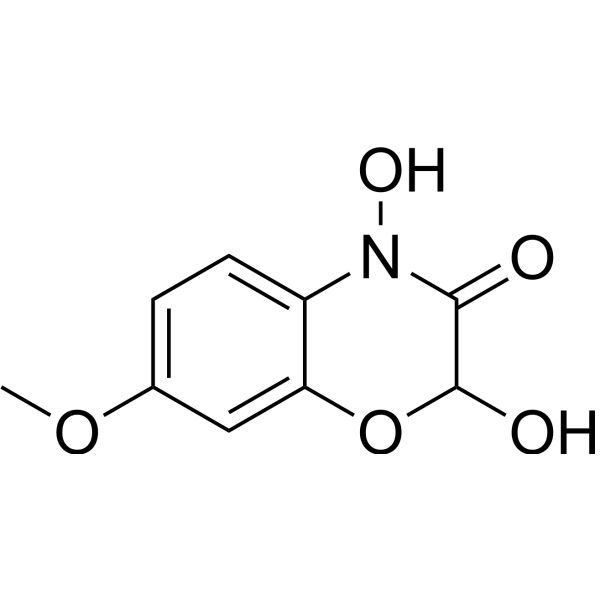
-
- HY-W127820
-
|
Tetrakis(2-N-methylpyridyl)porphine chloride
|
Biochemical Assay Reagents
Fluorescent Dye
|
Others
|
|
H2TMpyP-2 (tetrakis(2-N-methylpyridyl)porphine) chloride is an active photosensitizer with strong absorption properties in the visible to near-infrared region and excellent singlet oxygen quantum yield. Captisol-TMPyP complexes can be used in supramolecular nanosynthesis to increase singlet oxygen production, improve photostability and better photosensitization, and support photodynamic therapy activity. The Captisol:TMPyP complex also exhibited antibacterial activity against Escherichia coli and was cytotoxic against lung cancer A549 cells .
|
-
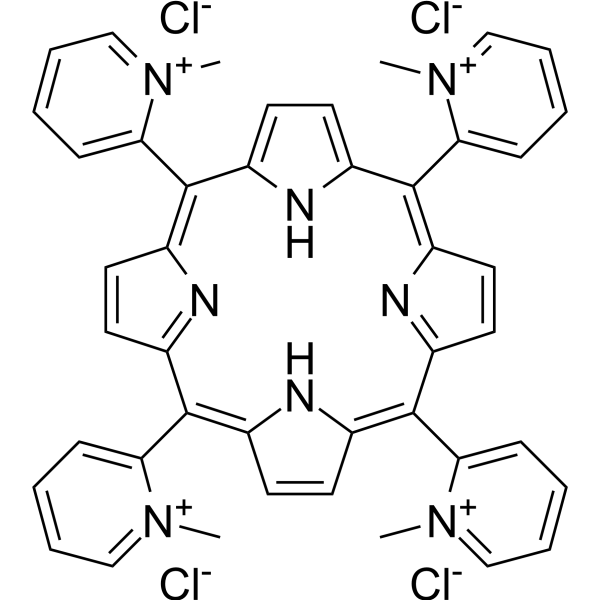
-
- HY-155527
-
|
|
SARS-CoV
|
Infection
|
|
SARS-CoV-2 Mpro-IN-9 (compound c7) is a nonpeptidic, noncovalent SARS-CoV-2 M pro inhibitor (IC50=0.085 μM), with improved physicochemical and drug metabolism and pharmacokinetics (DMPK) properties. SARS-CoV-2 Mpro-IN-9 inhibits viral replication (EC50=1.10 μM) in SARS-CoV-2-infected Vero E6 cells, while exhibits low cytotoxic effects (CC50>50 μM) .
|
-
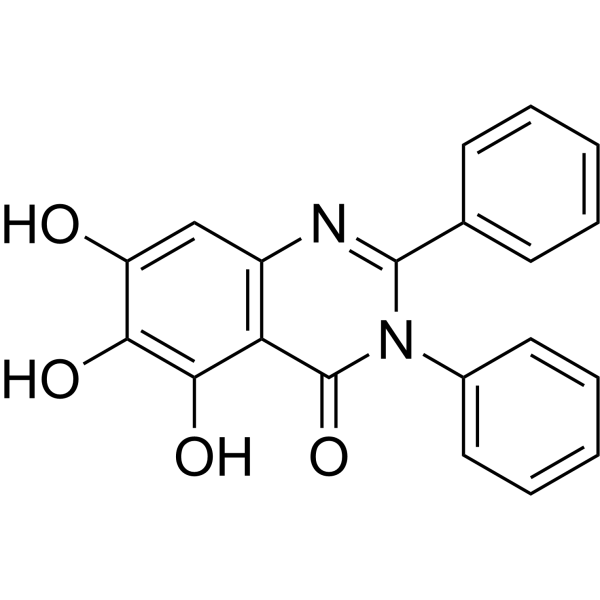
-
- HY-150979
-
|
|
Fluorescent Dye
|
Cancer
|
|
Gd-NMC-3 is a near-infrared fluorescence/magnetic resonance (NIRF/MR) bimodal imaging probe. Gd-NMC-3 shows high resolution and sensitivity in tumor imaging with good biocompatibility, indicating huge application potential .
|
-
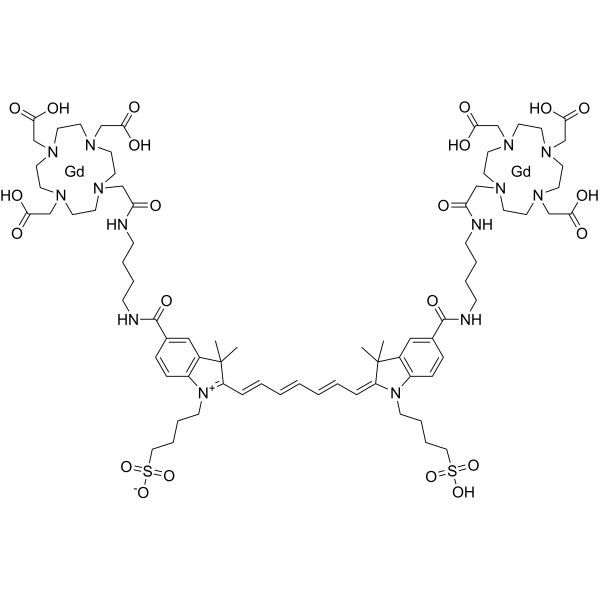
| Cat. No. |
Product Name |
Type |
-
- HY-D1504
-
|
|
Dyes
|
|
IR-797 chloride is a near-infrared (NIR) dye. IR 797 has absorption maxima near 700 nm. IR-797 shows some aggregation-induced-emission (AIE) properties. IR-797 shows shows cytotoxic .
|
-
- HY-150979
-
|
|
Fluorescent Dyes/Probes
|
|
Gd-NMC-3 is a near-infrared fluorescence/magnetic resonance (NIRF/MR) bimodal imaging probe. Gd-NMC-3 shows high resolution and sensitivity in tumor imaging with good biocompatibility, indicating huge application potential .
|
| Cat. No. |
Product Name |
Target |
Research Area |
-
- HY-P1940
-
|
Cyclo(Tyr-Pro)
|
Peptides
|
Cancer
|
|
Maculosin is a host-specific phytotoxin for spotted knapweed from Alternaria alternata. Maculosin is a quorum-sensing molecule involved in cell-cell communication by Pseudomonas aeruginosa. Maculosin also acts as a signaling molecule regulating virulence gene expression in Lactobacillus reuteri. Maculosin shows antioxidant, anti-cancer and non-toxicity properties. Maculosin shows cytotoxic activity against the human liver cancer cell lines, with an IC50 of 48.90 µg/mL .
|
-
- HY-P1632
-
|
|
Bacterial
|
Infection
Cancer
|
|
Tachyplesin I is a β-hairpin antimicrobial peptide that contains 17 amino acid residues. Tachyplesin I exhibits cytotoxic properties against various human tumor cell lines acting primarily by impairing the integrity of the outer cell membrane .
|
-
- HY-P2569
-
|
|
Apoptosis
|
Cancer
|
|
Malformin A1, a cyclic pentapeptide isolated from Aspergillus niger, possess a range of bioactive properties including antibacterial activity. Malformin A1 shows potent cytotoxic activities on human colorectal cancer cells. Malformin A1 induces apoptosis by activating PARP, caspase 3, -7, and -9 .
|
| Cat. No. |
Product Name |
Category |
Target |
Chemical Structure |
-
- HY-14944
-
-

-
- HY-N6714
-
-

-
- HY-N1621
-
-

-
- HY-N9737
-
-

-
- HY-N12524
-
-

-
- HY-N3968
-
-

-
- HY-N2732
-
-

-
- HY-N4020
-
-

-
- HY-N1318
-
-

-
- HY-N0206
-
-

-
- HY-N1243
-
-

-
- HY-15142A
-
-

-
- HY-N0446
-
-

-
- HY-P2569
-
-

-
- HY-N0057
-
|
3,4-Di-O-caffeoylquinic acid; Isochlorogenic acid B
|
Infection
Caprifoliaceae
Classification of Application Fields
Ketones, Aldehydes, Acids
Source classification
Phenols
Polyphenols
Plants
Endogenous metabolite
Disease Research Fields
|
Glucosidase
Influenza Virus
Apoptosis
Endogenous Metabolite
|
|
3,4-Dicaffeoylquinic acid (3,4-Di-O-caffeoylquinic acid), naturally isolated from Laggera alata, has antioxidative, DNA protective, neuroprotective and hepatoprotective properties. 3,4-Dicaffeoylquinic acid exerts apoptosis-mediated cytotoxicity and α-glucosidase inhibitory effects. 3,4-Dicaffeoylquinic acid possesses a unique mechanism of anti-influenza viral activity, that is, enhancing viral clearance by increasing TRAIL .
|
-

-
- HY-P1940
-
|
Cyclo(Tyr-Pro)
|
Alkaloids
Monophenols
Microorganisms
Pyrrole Alkaloids
Source classification
Phenols
Disease Research Fields
Cancer
|
Others
|
|
Maculosin is a host-specific phytotoxin for spotted knapweed from Alternaria alternata. Maculosin is a quorum-sensing molecule involved in cell-cell communication by Pseudomonas aeruginosa. Maculosin also acts as a signaling molecule regulating virulence gene expression in Lactobacillus reuteri. Maculosin shows antioxidant, anti-cancer and non-toxicity properties. Maculosin shows cytotoxic activity against the human liver cancer cell lines, with an IC50 of 48.90 µg/mL .
|
-

-
- HY-N7432
-
-

| Cat. No. |
Product Name |
Chemical Structure |
-
- HY-N1318S
-
|
|
|
Salvigenin-d9 is the deuterium labeled Salvigenin. Salvigenin is a natural polyphenolic compound, with neuroprotective effect. Salvigenin has antitumor cytotoxic and immunomodulatory properties[1][2].
|
-

-
- HY-N0006S
-
|
|
|
Demethoxycurcumin-d7 is the deuterium labeled Demethoxycurcumin. Demethoxycurcumin(Curcumin II), a major active curcuminoid, possess anti-inflammatory properties; also exert cytotoxic effects in human cancer cells via induction of apoptosis.
|
-

Your information is safe with us. * Required Fields.
Inquiry Information
- Product Name:
- Cat. No.:
- Quantity:
- MCE Japan Authorized Agent:
























































